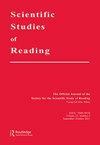Scanpath Regularity as an Index of Reading Comprehension
IF 2.4
2区 教育学
Q1 EDUCATION & EDUCATIONAL RESEARCH
引用次数: 1
Abstract
Purpose: Recent research on the potential of using eye-tracking to measure reading comprehension ability suggests that the relationship between standard eye-tracking measures and reading comprehension is influenced by differences in task demands between comprehension assessments. We compared standard eye-tracking measures and scanpath regularity as predictors of reading comprehension scores. Method: We used a dataset in which 79 participants (mean age: 22 years, 82% females, 76% monolingual English speakers) were administered three widely-used reading comprehension assessments with varying task demands while their eye movements were monitored: the York Assessment of Reading for Comprehension ; (YARC), the Gray Oral Reading Test ; (GORT-5), and the sentence comprehension subtest of the Wide Range Achievement Test ; (WRAT-4). Results: Results showed that scanpath regularity measures, similarly to standard eye-tracking measures, were influenced by differences in task demands between the three tests. Nevertheless, both types of eye-tracking measures made unique contributions as predictors of comprehension and the best set of predictors included both standard eye-tracking measures and at least one scanpath measure across tests. Conclusion: The results provide evidence that scanpaths capture differences in eye-movement patterns missed by standard eye-tracking measures. Overall, the results highlight the effect of task demands on eye-movement behavior and suggest that reading goals and task demands need to be considered when interpreting eye-tracking data.扫描规律作为阅读理解的指标
本文章由计算机程序翻译,如有差异,请以英文原文为准。
求助全文
约1分钟内获得全文
求助全文
来源期刊

Scientific Studies of Reading
Multiple-
CiteScore
7.20
自引率
2.70%
发文量
26
期刊介绍:
This journal publishes original empirical investigations dealing with all aspects of reading and its related areas, and, occasionally, scholarly reviews of the literature, papers focused on theory development, and discussions of social policy issues. Papers range from very basic studies to those whose main thrust is toward educational practice. The journal also includes work on "all aspects of reading and its related areas," a phrase that is sufficiently general to encompass issues related to word recognition, comprehension, writing, intervention, and assessment involving very young children and/or adults.
 求助内容:
求助内容: 应助结果提醒方式:
应助结果提醒方式:


